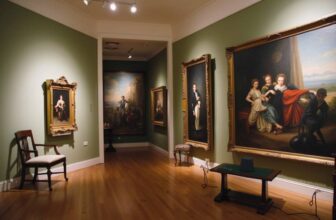
The mysterious Painting Salvator Mundi
The fascinating and controversial story surrounding Salvator Mundi and its mysterious buyer. This tale explores the painting’s history, sale, controversies, and the implications of its enigmatic acquisition.
The Enigma of Salvator Mundi: A Masterpiece or a Master Manipulation?
Salvator Mundi Latin for “Savior of the World” is often described as one of the most controversial artworks in modern history. Allegedly painted by Leonardo da Vinci, the work depicts Christ holding a crystal orb, symbolizing the heavens. Its journey from obscurity to the pinnacle of the art market has captivated the world, culminating in its record-breaking sale in 2017 for $450.3 million. However, the identity of its buyer and the painting’s provenance continue to fuel intrigue and debate.
A Masterpiece Rediscovered
For centuries, Salvator Mundi languished in obscurity. Originally thought to have been lost or destroyed, the painting reemerged in 2005 when art dealers Robert Simon and Alexander Parish purchased it at a small New Orleans auction for just $1,175. The piece was heavily overpainted, damaged, and misattributed to a follower of Leonardo. However, upon restoration, some experts claimed it bore the hallmarks of Leonardo’s hand, sparking a heated debate about its authenticity.
After its restoration, Salvator Mundi was included in the National Gallery’s 2011-2012 Leonardo da Vinci exhibition in London, which lent credence to its attribution. Yet, the question of whether Leonardo himself painted the work or if it was largely executed by his workshop remains unresolved. Critics argue that the painting lacks the finesse of da Vinci’s other works, pointing to inconsistencies in the drapery and the orb’s depiction.
The Record-Breaking Sale
In 2017, Salvator Mundi was auctioned by Christie’s in New York. The painting shattered all previous records, selling for $450.3 million. The auction house marketed it as “The Last da Vinci,” playing on its rarity and mystique. The identity of the buyer was initially shrouded in secrecy, sparking global speculation.
Reports later revealed that the buyer was Prince Badr bin Abdullah bin Mohammed bin Farhan Al Saud, a relatively obscure member of Saudi Arabia’s royal family. However, many believe he acted on behalf of Crown Prince Mohammed bin Salman (MBS), the de facto ruler of Saudi Arabia. This theory aligns with Saudi Arabia’s recent efforts to position itself as a cultural powerhouse through initiatives like Vision 2030, which includes investments in art and tourism.
Why Would Saudi Arabia Buy Salvator Mundi?
The acquisition of Salvator Mundi by Saudi Arabia raises several questions. Why would a predominantly Muslim country with no significant historical tradition of collecting Western art spend nearly half a billion dollars on a Christian-themed painting?
Cultural Prestige and Soft Power
One plausible explanation lies in Saudi Arabia’s ambition to project itself as a global cultural leader. By acquiring a work of such prominence, the kingdom could assert its place on the international stage. The painting’s association with Leonardo da Vinci, a symbol of universal genius, aligns with Saudi Arabia’s desire to rebrand itself as modern and forward-thinking.
Diplomatic Motivations
The purchase also holds potential geopolitical implications. The year Salvator Mundi was sold coincided with warming relations between Saudi Arabia and the Vatican. Displaying a Christian-themed masterpiece could be seen as a gesture of goodwill toward fostering interfaith dialogue.
A Monumental Trophy
The painting’s status as the most expensive artwork ever sold makes it an unparalleled trophy. Owning Salvator Mundi confers a unique form of prestige, particularly for MBS, who is known for his ambitious and sometimes audacious projects.
The Mystery of Its Location
After its purchase, Salvator Mundi vanished from public view. It was reportedly intended for display at the Louvre Abu Dhabi, a key project in Saudi Arabia’s cultural strategy. However, the unveiling, initially scheduled for late 2018, was mysteriously canceled, and the painting’s whereabouts remain unknown.
Some reports suggest it may be aboard MBS’s superyacht, Serene, while others speculate it is stored in a secure location in Saudi Arabia. The lack of transparency has fueled conspiracy theories, with some questioning whether the painting is being hidden due to doubts about its authenticity.
Controversies and Criticisms
The purchase of Salvator Mundi has not been without backlash. Critics argue that the astronomical price paid for the painting highlights the excesses of the global art market, where wealth and prestige often trump artistic merit. The painting’s authenticity continues to divide experts, with some labeling it a “Leonardo” and others viewing it as a collaborative work with limited input from the master himself.
The secrecy surrounding the painting’s current location and condition only adds to the skepticism. If Salvator Mundi is indeed aboard MBS’s yacht, it raises ethical questions about the privatization of cultural heritage. Conversely, if the painting is being withheld due to authenticity concerns, it undermines the credibility of its record-breaking sale.
Implications for the Art World
The sale of Salvator Mundi has had far reaching implications for the art world. It has underscored the role of marketing and spectacle in driving art sales, as Christie’s innovative auction campaign played a significant role in generating buzz. The painting’s story also highlights the growing influence of wealthy collectors from regions like the Middle East and Asia, who are reshaping the art market.
Moreover, the controversy surrounding Salvator Mundi has sparked renewed debates about the ethics of attribution and the role of institutions in validating artworks. The National Gallery’s decision to exhibit the painting as a Leonardo lent it a level of credibility that significantly influenced its sale, raising questions about the responsibility of museums in such cases.
The Symbolism of Salvator Mundi
At its core, Salvator Mundi is a symbol. For some, it represents the enduring allure of Leonardo da Vinci and the timeless appeal of his genius. For others, it is a cautionary tale about the excesses of the art market and the power of branding.
The painting’s journey from obscurity to fame, its record-breaking sale, and its mysterious disappearance encapsulate the complexities of the modern art world. It serves as a reminder of the interplay between art, money, and power, and how these forces shape the narratives we construct around cultural heritage
The story of Salvator Mundi is far from over. Its enigmatic buyer, hidden location, and unresolved attribution ensure that it will remain a topic of fascination for years to come. Whether it is ultimately remembered as a genuine Leonardo masterpiece, a symbol of cultural ambition, or a cautionary tale of market excess will depend on how its story continues to unfold. For now, Salvator Mundi stands as a testament to the enduring mysteries and allure of the art world.




